Chemical plant wastewater treatment
Chemical plant wastewater treatment was failing to meet discharge limits, installed a Dynatec UF system to separate emulsified fats, oils, and grease (FOG) from their permeate. The raw wastewater has more than 2,000ppm of emulsified FOG with peaks much higher at times. The system consists of four UF units and related components. The system currently treats 66gpm, but all 4 units are expandable. The permeate is free of FOG and is acceptable for discharge.
https://www.dynatecsystems.com/technologies/membrane-technologies/ultrafiltration-systems/
Chemical wastewater treatment utilizing membrane systems that range from selective separation of product to wastewater treatment and reuse. Dynatec Systems has provided many different chemical wastewater solutions.
Chemical Wastewater Treatment Solutions
- Ultrafiltration (UF), Nanofiltration (NF) and Reverse Osmosis (RO) for selective separation of product for recovery
- MBR biological treatment
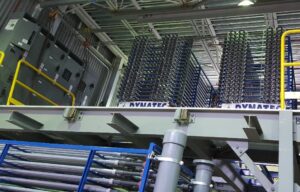
- Wastewater reuse with MBR
- Conversions of existing systems to MBR
- Expand existing bioreactor treatment capacity
- Improve discharge quality
- Produce water for reuse
- Reduce surcharge
- High purity reuse with MBR and RO
Contaminants Removed
- Organics
- Inorganic solids
- Phenol
- Solvents
- Oils
- Acids
Ultrafiltration offers the following advantages over conventional separation:
- No chemical required
- Very little labor required
- Simple mechanical process
- Less sludge
- Ability to concentrate the retentate for beneficial use
- Less space required
- Overall lower operating costs
Dynatec specializes in extensive RO and NF membrane systems to remove soluble components of wastewater that may not have been removed by primary treatment. In most cases, the purified water can be reused.
RO is capable of rejecting soluble constituents of aqueous streams, such as:
- Bacteria
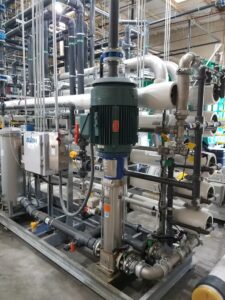
- Salts
- Sugars
- Proteins
- A wide range of organics and colors
- Improves the color, taste and properties of the fluid
RO can be used to purify fluids such as ethanol, which will pass through the reverse osmosis membrane, while rejecting other ions and contaminants from passing.
RO/NF systems
The most common use for reverse osmosis is in purifying water. It is used to produce water that meets the most demanding specifications. This differs significantly from other RO systems that are often only designed to treat potable water. Our system is specifically designed to accommodate:
- Minimize reject volume
- Variable characteristics
- Minimize fouling
RO and NF Technology
RO uses a membrane that is semi-permeable, allowing the fluid that is being purified to pass through it, while rejecting the contaminants that remain. Most NF and RO systems are operated in crossflow to allow the membrane to continually clean itself.
Integrated clean-in-place (CIP)
The membrane skid has an integrated CIP system on the skid. This is especially important for wastewater reuse systems because the cleaning frequency of the skid is often higher than in other RO applications. With an integrated CIP system, cleaning is fast and easy, minimizing the operator’s time.
Tubular Configuration:
- Higher permeate rate
- Lower rates of fouling
- Higher concentration of retentate
- Easier to clean
- Longer membrane life
- Low operating cost
To discuss your wastewater treatment solution, please contact us today.
MBR RO for Reuse
MBR RO for reuse, A domestic manufacturer of personal protective equipment is undergoing a major plant expansion. The company now needs to treat their wastewater for reuse as they discharge to a small POTW that could not handle the new volumes or contaminant loading. The new wastewater treatment plant is being built in stages. The first system is a relatively small MBR to handle the first phase of their expanded production. The second system is designed to handle their full-scale production, which will only be several months after the first phase is completed. This system includes an EQ tank, MBR with pre and post anoxic tanks and tubular UF, and RO. The system is designed so that all the RO permeate can be reused while the RO reject can be discharged to the local POTW. One of the goals of the MBR is to reduce nitrates from a high initial concentration to very low levels so that the RO reject will meet that total nitrogen limits for discharge to the POTW. The plant is designed so that future expansion is easily achieved. 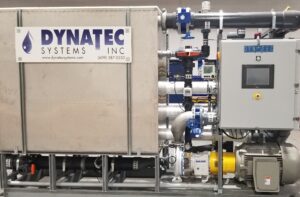
Recovery and reuse systems have been provided by Dynatec Systems to many industries. The ability to recover and reuse water has many benefits.
- Saving on water costs
- Saving on wastewater disposal charges
- Decreased environmental impact
- Protection from regulatory changes
- Decrease dependence on water provider/source
- Ability to expand without affecting water demand
- Overcome water scarcity issues
- Consistently high-quality for water reuse
Ultrafiltration (UF), Membrane Bioreactor (MBR), Nanofiltration (NF) and Reverse Osmosis (RO) are employed by Dynatec for water reuse projects. Water recovery and water reuse has been successfully implemented with industrial and sanitary wastewater streams for: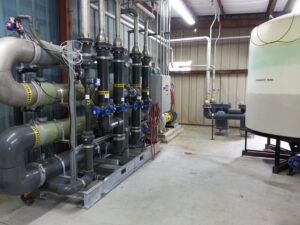
- Cooling tower make up
- Boiler feed
- Irrigation
- Toilet flushing
- Direct potable reuse
- Cleaning/wash applications
- Rinse processes
- Painting processes
- Other plant processes
Recovery and reuse systems provided by Dynatec Systems:
- Resorts, hotels, and retirement homes
- Golf courses
- Automotive companies
- Food and beverage companies
- Apartment buildings
- Landfills
- Mines
- Metal finishing plants
- Aerospace companies
For more information about wastewater reuse, contact us today.
https://www.dynatecsystems.com/technologies/recovery-and-reuse/
MBR Conversion – Pharmaceutical Company
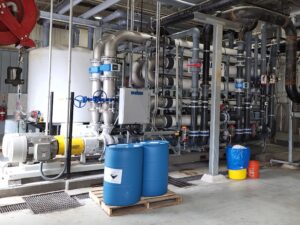 A pharmaceutical firm suffered from frequent upsets to their existing treatment process. The existing conventional aerobic biological system followed by a gravity clarifier, led to discharge noncompliance.
A pharmaceutical firm suffered from frequent upsets to their existing treatment process. The existing conventional aerobic biological system followed by a gravity clarifier, led to discharge noncompliance.
Dynatec completed bench top treatability studies and pilot studies to confirm the best method to improve performance. Adding ultrafilters as part of the conversion to a Membrane Bioreactor (MBR) was the best course of action.
MBR Conversion – Pharmaceutical Company
The wastewater stream was high in organic content (BOD, COD), and suspended solids (TSS). The MBR conversion, using a Dynatec ultrafiltration system allowed the customer to run the biological system at high mixed liquor concentrations without concern for settling characteristics. The higher mixed liquor concentration and longer sludge age proved to be successful in consistently reducing BOD and COD into compliance.
The system was designed to treat nearly 300,000 gallons per day. The COD was consistently reduced to 300 – 500 mg/l from 14,000 mg/l while BOD was reduced to non-detect.
The upgraded system handled variable loads in terms of organic load and flow rates. It consistently delivered high-quality effluent with less operator attention than their previous system. Additionally, the customer no longer faced fines for exceeding discharge limits for organics and solids.
Dynatec completed the process design, provided the equipment, and performed the installation. Existing tanks and aeration were utilized, keeping the conversion cost to less than any alternative.
Dynatec Systems industry-leading tubular ultrafiltration (UF) system can be used to treat a broad range of industrial wastewater by separating insoluble components from waste streams. As a cost effective and simple solution for separating insoluble components and colloidal contaminants from a waste stream. Wastewater ultrafiltration offers significant advantages over conventional separation. It is a useful process that does not require chemicals or much space to separate insoluble contaminants.
Contact Dynatec to discuss your wastewater treatment needs.
https://www.dynatecsystems.com/technologies/membrane-bioreactors/mbr-conversion-r…pgrade-solutions/
Wastewater reuse
Wastewater reuse is achieved at an automotive plant. Wastewater equipment to treat both sanitary and production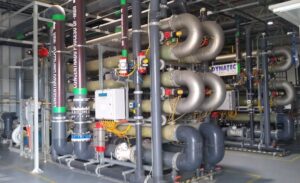 wastewater that included oily waste was designed and installed in a new transmission manufacturing facility. The goal was to treat and purify water for reuse.
wastewater that included oily waste was designed and installed in a new transmission manufacturing facility. The goal was to treat and purify water for reuse.
Dynatec met these demands by providing a membrane bioreactor (MBR) followed by a reverse osmosis (RO) system. The MBR reduced BOD, TSS, and oil and grease to non-detect levels. The RO is used to polish the MBR effluent so that it is suitable for reuse. It is reused in cleaning operations, cooling tower, and all production applications.
80%-90% of the wastewater is purified for reuse. Additional industrial park wastewater (after primary clarification at the industrial park) is introduced to the system for treatment and purification. The system is designed to receive 300,000gpd and purify 250,000gpd for reuse.
This novel approach greatly reduced the total amount of wastewater discharged by this plant. It provided the water needed for production using a comprehensive system that Dynatec designed, supplied and installed.
Ultrafiltration (UF), Membrane Bioreactor (MBR), Nanofiltration (NF) and Reverse Osmosis (RO) are employed by Dynatec for these wastewater projects. Wastewater recovery and reuse has been successfully implemented with industrial and sanitary wastewater streams for: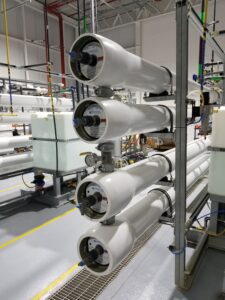
- Cooling tower make up
- Boiler feed
- Irrigation
- Toilet flushing
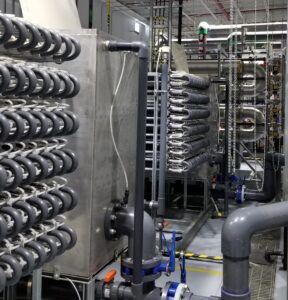
- Direct potable reuse
- Cleaning/wash applications
- Rinse processes
- Painting processes
- Other plant processes
For more information on wastewater reuse, please contact us today.
https://www.dynatecsystems.com/technologies/recovery-and-reuse/
High Quality Discharge MBR
Dynatec provides High Quality Discharge MBR system for Retirement Home
The retirement community consists of independent living homes and apartment homes in rural Maryland. The facility is in horse country, in a valley among rolling hills, and shares the area with high-end homes.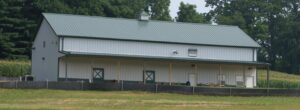
Previously, the facility had two septic tanks, and a recirculated sand bed filtration system. This created odors and caused mosquito infestations in summer. The facility chronically missed discharge limits, and thus was paying frequent fines. The sand bed filtration system was high maintenance, constantly flooding and requiring maintenance.
Replacement Criteria
In deciding on a replacement system, several criteria were important to the facility and to State regulators. The plant must be aesthetically pleasing. Odors must be minimized and if possible, eliminated. The plant had to achieve high levels of treatment to meet present and future discharge requirements. Future use of the treated water for irrigation is planned. The plant had to be operator friendly, and be capable of being monitored remotely, since full-time staff would not be available. The plant must be cost effective, from both capital and operating standpoints. Finally, the plant must be modular, in that future expansion of the facility must be accommodated in the design.
The initial plant sizing was nominally for 50,000 gallons per day of treatment capacity and has been expanded to 100,000 gallons per day.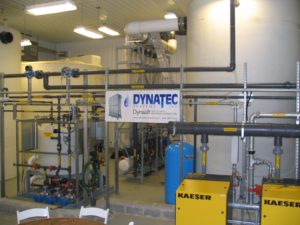
System Design
After a review of the available treatment options, the owners of the facility decided on the (MBR) Membrane Bioreactor option. Due to the modular design of the system, they also chose the out-of-basin membrane module concept provided by the Dynatec MBR system. This process combines ease of use with all the requirements of both the owners and the regulators.
Odor control is achieved by using closed tanks vented to atmosphere. Air from the screening room is used to provide aeration to the reactors and the membranes, using the biomass as a biofilter. The negative pressure in the screen room ensures that there are no fugitive odors from the area. Mixing and aeration of the EQ tanks (the existing septic tanks) ensures no odors from that area.
Design Compatibility with the area: due to the nature of the area, the plant was designed to be installed in a “horse barn”, or at least a building that looks like a horse barn, but in fact, contains both the treatment plant and space for landscaping and other equipment.
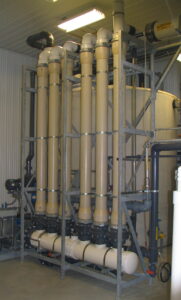 High Levels of Treatment have been achieved since the plant’s inception in early 2007. Performance has been maintained since that time. Future plans include treatment for Total-N and Total-P to comply with Maryland’s “flush tax” requirements.
High Levels of Treatment have been achieved since the plant’s inception in early 2007. Performance has been maintained since that time. Future plans include treatment for Total-N and Total-P to comply with Maryland’s “flush tax” requirements.
Cost Effective Installation was achieved using standard above-ground HDPE tanks, rather than the more common concrete tanks
Plant Expandability was achieved by the installation of one half of the plant, and the addition of a second membrane rack. No modifications to tanks or other work were required in 2009.
Conclusions:
Since completion and startup in early 2007, the plant has reliably performed, always producing high-quality water.
The Dynatec MBR concept provides economic advantages due to the modular design and the use of standard tanks. The cost of operation is modest when compared to alternatives.
Contact Dynatec Systems today to discuss your sanitary wastewater solution.
https://www.dynatecsystems.com/industries/sanitary-wastewater/
Flexographic Ink Wastewater Treatment
FLEXOGRAPHIC INK WASTEWATER TREATMENT
A corrugated box manufacturer utilized conventional batch physical/chemical treatment for processing wastewater generated from the clean-up of flexographic ink wastewater. The system consisted of chemical coagulation followed by conventional flocculation. A deep bed filter was used to clarify and dewater the waste. The system was operator intensive and generated lots of sludge for disposal.
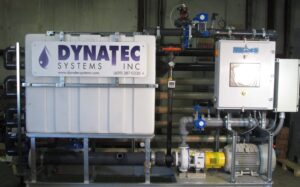
Solution:
A tubular non-clog membrane filtration system was installed to process the waste stream. The waste was pH adjusted to optimize the removal of copper and zinc. The waste was circulated through the filter for discharge and the contaminants were concentrated. The
concentrate of contaminants was reduced to 2% of the original volume. The system reliably produces high quality water with very little operator involvement.
Simple Mechanical Process:
The membrane filter is a mechanical system that allows clean water to pass through the filter while contaminants are rejected and returned to the waste holding tank. There are no chemicals required other than that which may be necessary for pH adjustment. Also, there is no sludge generated by the process. The system simply separates the contaminants from the water, whereas a chemical treatment system generates copious amounts of sludge that must be dewatered and disposed.
Unattended Operation:
Since this process is completely mechanical and not dependent upon chemical feed and the coagulation and flocculation process, the only operational requirement is to clean the membrane filters periodically. This is a simple process that involves less than one half hour of an operator’s time. A chemical treatment system requires ongoing adjustments of the chemical feed pumps, make-up of the chemical feeds, operation of the dewatering system and control calibration and adjustment. The chemical system tasks require continual attention on a daily basis, whereas the membrane filtration system requires attention only for cleaning.
Consistently High Quality Water:
The membrane filter forms a positive barrier to the flow of contaminants, producing continuous high-quality water without operator attention. The membrane system is not affected by variability of the waste stream. The purified water is suitable for reuse or sewer discharge.
Low Disposal Cost:
The mechanical separation produced by the membrane filter does not generate sludge. It simply separates the contaminants from the water and leaves those contaminants in a liquid phase. The amount of liquid concentrate is normally very small and it is, therefore, cost-effective to dispose of that concentrate as a liquid waste and thereby preclude the need to run and operate a solidification and de-watering operation.
Low Operating Cost:
The membrane filtration system will be the least expensive treatment system to operate. The cost of operation of a membrane filtration system is much less than a chemical treatment system.
Contact Dynatec Systems today to discuss your wastewater solution today.
MBR for transmissivity improvement
MBR for transmissivity improvement – Dynatec provided a low pressure nanofiltration (NF) system to remove humic and fulvic acid to improve the transmissivity (UVT) of treated water discharge. The NF system also minimizes the reject volume making the membrane approach practical.
Demands for development of membranes with specific performance continue to increase as water quality requirements tighten and water treatment system designs become more complex.
Where UV is employed for disinfection the requirement for transmissivity improvement has become important at many facilities.
The NF membrane typically rejects only larger polyvalent cations and anions and as a result produces a very small volume of reject.
MBR for transmissivity
Nanofiltration systems are typically used for:
- Color removal from surface water sources including removal of disinfection precursors
- Retention of humic and fulvic acids in landfill leachate to improve UV transmissivity
- Pharmaceutical solvent recovery and management
- Removal of tar compounds in petroleum industry
- Separation of blood compounds in medicine
- Water softening
Dynatec specializes in extensive industrial reverse osmosis (RO) membrane systems and nanofiltration (NF) membrane systems to remove soluble components of wastewater that may not have been removed by primary treatment. In most cases, the purified water can be reused.
RO is capable of rejecting soluble constituents of aqueous streams, such as:
- Bacteria

- Salts
- Sugars
- Proteins
- A wide range of organics and colors
- Improves the color, taste and properties of the fluid
This process is commonly used to purify water and remove salts and other impurities. It can be used to purify fluids such as ethanol, which will pass through the reverse osmosis membrane, while rejecting other ions and contaminants from passing.
Industrial Reverse Osmosis/Nanofiltration systems
The most common use for reverse osmosis is in purifying water. It is used to produce water that meets the most demanding specifications. This differs significantly from other RO systems that are often only designed to treat potable water. Our system is specifically designed to accommodate:
- Minimize reject volume
- Variable characteristics
- Minimize fouling
RO and NF Technology
RO uses a membrane that is semi-permeable, allowing the fluid that is being purified to pass through it, while rejecting the contaminants that remain. Most NF and RO systems are operated in crossflow to allow the membrane to continually clean itself.
Integrated clean-in-place (CIP)
The membrane skid has an integrated CIP system on the skid. This is especially important for wastewater reuse systems because the cleaning frequency of the skid is often higher than in other RO applications. With an integrated CIP system, cleaning is fast and easy, minimizing the operator’s time.
For more information on nanofiltration, please contact us today.
Chemical Manufacturer Wastewater Treatment
A chemical manufacturer issued a PO for a new wastewater treatment system from Dynatec. Our customer is in the process of a major plant expansion and needed to meet new, stricter discharge limits. The wastewater is high in oil and grease, BOD, and COD. The new system will consist of an ultrafiltration system followed by a membrane bioreactor (MBR). The performance of this system was proven over several months of piloting. The results confirmed the selection of UF followed by MBR. The BOD in the permeate was regularly non-detect, down from as high as 40,000ppm in the raw wastewater. All other discharge limits were easily met.
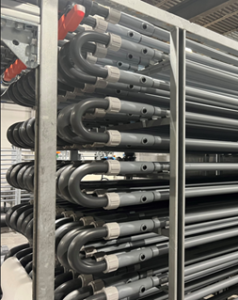
Chemical wastewater treatment utilizing membrane systems that range from selective separation of product to wastewater treatment and reuse. Dynatec Systems has provided many different chemical wastewater solutions.
- Ultrafiltration (UF), Nanofiltration (NF) and Reverse Osmosis (RO) for selective separation of product for recovery
- MBR biological treatment
- Wastewater reuse with MBR
- Conversions of existing systems to MBR
- Expand existing bioreactor treatment capacity
- Improve discharge quality
- Produce water for reuse
- Reduce surcharge
- High purity reuse with MBR and RO
Contaminants Removed
- Organics
- Inorganic solids
- Phenol
- Solvents
- Oils
- Acids
Ultrafiltration offers the following advantages over conventional separation:
- No chemical required
- Very little labor required
- Simple mechanical process
- Less sludge
- Ability to concentrate the retentate for beneficial use
- Less space required
- Overall lower operating costs
Dynatec specializes in extensive RO and NF membrane systems to remove soluble components of wastewater that may not have been removed by primary treatment. In most cases, the purified water can be reused.
RO is capable of rejecting soluble constituents of aqueous streams, such as:
- Bacteria

- Salts
- Sugars
- Proteins
- A wide range of organics and colors
- Improves the color, taste and properties of the fluid
RO can be used to purify fluids such as ethanol, which will pass through the reverse osmosis membrane, while rejecting other ions and contaminants from passing.
RO/NF systems
The most common use for reverse osmosis is in purifying water. It is used to produce water that meets the most demanding specifications. This differs significantly from other RO systems that are often only designed to treat potable water. Our system is specifically designed to accommodate:
- Minimize reject volume
- Variable characteristics
- Minimize fouling
RO and NF Technology
RO uses a membrane that is semi-permeable, allowing the fluid that is being purified to pass through it, while rejecting the contaminants that remain. Most NF and RO systems are operated in crossflow to allow the membrane to continually clean itself.
Integrated clean-in-place (CIP)
The membrane skid has an integrated CIP system on the skid. This is especially important for wastewater reuse systems because the cleaning frequency of the skid is often higher than in other RO applications. With an integrated CIP system, cleaning is fast and easy, minimizing the operator’s time.
Tubular Configuration:
- Higher permeate rate
- Lower rates of fouling
- Higher concentration of retentate
- Easier to clean
- Longer membrane life
- Low operating cost
To discuss your wastewater treatment solution, please contact us today.
https://www.dynatecsystems.com/technologies/membrane-bioreactors/mbr-conversion-r…pgrade-solutions/
Reuse Water with MBR
High-quality discharge and reuse from MBR
Dynatec Provides Reuse Water for Cereals Plant
Dynatec Systems, Inc. has installed a water reuse system in a major cereals plant in Georgia.
The complete treatment system, consisting of a membrane bioreactor (MBR), followed by reverse osmosis (RO), provides a net savings to the plant of more than $3,000 per day in water and sewer charges after deduction of the plant operating costs. The water is reused for cleaning, in scrubbers and in boilers.
Previously, the facility discharged all the wastewater to a municipal treatment plant at a rate of up to 0.5 mgd, and paid both volume and load charges
Quality Criteria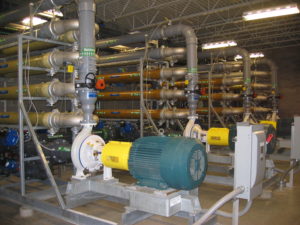
Since the plant produces a food product, ultimate water quality is vital. The two-stage membrane system (MBR + RO) and final sterilization with ultraviolet (UV) treatment provides the quality assurance that plant management requires. In addition, the membranes used in the MBR system are external to the aeration basin and are tubular. This type of membrane is much less susceptible to failure than the immersed type.
System Design
After a review of the available treatment options, the owners of the facility chose the Dynatec bioreactor option. This process combines aerated biological treatment with an out-of-basin ultrafiltration (UF) system. In combination with reverse osmosis treatment, Dynatec was able to provide the client with the necessary assurances that the water quality would not be compromised, and that the water would be suitable for process purposes, such as boiler feed water.
Dynatec’s design consisted of the following components:
- Internally fed rotary screen
- 500,000 gallon above-ground stainless steel equalization tank with jet aeration and duplex PD blowers
- 500,000 gallon above-ground stainless steel aerated biological reactor with jet aeration and triplex PD blowers
- Four membrane skids with a common automated CIP (clean-in-place) system, one skid operates in standby mode
- Reverse Osmosis system
- Final UV (ultraviolet) sterilization
- Sludge dewatering decanter centrifuge
- Completely integrated control system managing all system functions
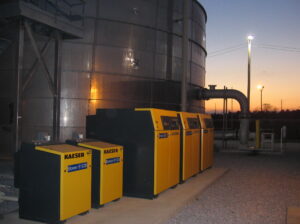
System Advantages:
- The system provides many advantages for the operators and owners.
- Redundant membrane skids for ease of operation and cleaning.
- Simple automated cleaning operations with membranes in place.
- High mixed liquor concentration ensures the lowest possible sludge production, and requires smallest possible footprint.
- Simple, low maintenance system.
- Long-lasting tubular membranes with 0.03 μm membrane, ensuring removal of bacteria and viruses.
Results:
The system has produced high quality water for reuse. Consistently, the water quality from the MBR has been as follows:
| Analytic | Units | Influent | MBR Effluent |
| BOD5 | Mg/L | 1200 | <5 |
| COD | Mg/L | 20 | |
| TSS | Mg/L | No data | ND |
State Award
The facility received an award from the State of Georgia Association of Water Professionals presented an award to the
facility for Outstanding Operation of a facility in the category of Water Conservation.
Project Conclusion:
The project was completed on time and within budget, and has exceeded the estimates that were initially made for cost savings.
The Dynatec system has proved to be reliable and efficient, and has exceeded the customer’s requirements, based on the initial
projected performance.
Technology Benefits
Biological treatment using Membrane Bioreactors provides several benefits:
- Consistently high-quality water
- No upsets, since the membrane provides a positive barrier to bacteria and viruses
- Smaller footprint than conventional systems, due to operation at high levels of mixed liquor
- Better system kinetics than conventional systems, due to long sludge age
- Complete removal of bacteria and viruses
- High quality water for reuse
- Dynatec Out-of-Basin MBR Systems:
- Operators never come in contact with biomass
- Easy clean-in-place without moving membranes
https://www.dynatecsystems.com/industries/food-and-beverage/
ZLD wastewater treatment system
ZLD wastewater treatment system for a food processing company was provided by Dynatec. The primary treatment is provided by a tubular membrane bioreactor (MBR) followed by reverse osmosis (RO). Membrane bioreactor permeate is reused for cooling tower make up. Reverse osmosis permeate is re-used for high-quality users and reverse osmosis (RO) reject is used for irrigation.
ZLD wastewater treatment system
Recovery and reuse systems have been provided by Dynatec Systems to many industries. The ability to recover and reuse water has many benefits.
- Saving on water costs
- Saving on wastewater disposal charges
- Decreased environmental impact
- Protection from regulatory changes
- Decrease dependence on water provider/source
- Ability to expand without affecting water demand
- Overcome water scarcity issues
- Consistently high-quality for water reuse
Ultrafiltration (UF), Membrane Bioreactor (MBR), Nanofiltration (NF) and Reverse Osmosis (RO) are employed by Dynatec for water reuse projects. Water recovery and water reuse has been successfully implemented with industrial and sanitary wastewater streams for:
- Cooling tower make up
- Boiler feed
- Irrigation
- Toilet flushing
- Direct potable reuse
- Cleaning/wash applications
- Rinse processes
- Painting processes
- Other plant processes
Recovery and reuse systems provided by Dynatec Systems:
- Resorts, hotels, and retirement homes
- Golf courses
- Automotive companies
- Food and beverage companies
- Apartment buildings
- Landfills
- Mines
- Metal finishing plants
- Aerospace companies
Membrane Bioreactors
Membrane bioreactors offer a unique and effective solution for the treatment and reuse of industrial wastewater in industries such as landfills, automotive, aerostructures, distilleries and dairies. Our industry-leading designs and innovation also deliver superior performance for sanitary wastewater and biological nutrient removal applications.
The MBR configuration has proven to be optimal for treatment of many industrial wastewaters when treatment efficiency is an important consideration.
The MBR is the ideal bioreactor configuration for treatment of organic or inorganic contaminants present in industrial wastewaters. MBRs operate at a higher efficiency while achieving consistent design performance objectives. This makes MBR a more cost effective method of treatment when performance and tank requirements are considered.
Bioreactor systems such as the conventional activated sludge system, sequencing batch reactor system and trickling filters are typically designed for operation at a lower volumetric removal rate, requiring larger tanks and more space. These conventional systems often experience upsets that inhibit settling and therefore require much more operator attention than a membrane bioreactor.
The MBR has proven to be optimal for treatment of many industrial wastewaters because it is less susceptible to upsets. The MBR’s performance is not affected by changes in sludge settleability like the conventional systems, making MBR a wise choice for industrial systems that have more difficult to treat waste streams. Dynatec has over 45 years experience in dealing with difficult to treat industrial wastewaters using membrane filtration.
For more information on zero-liquid discharge (ZLD) wastewater treatment systems, please contact us today.
https://www.dynatecsystems.com/technologies/recovery-and-reuse/
